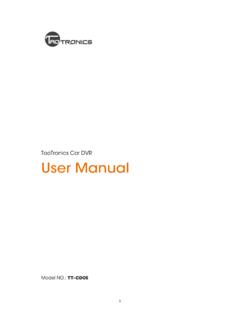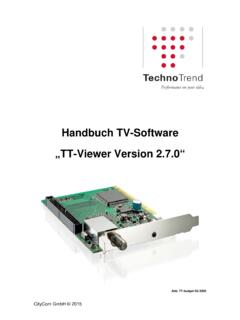Transcription of Rosemount 644H Temperature Transmitters - …
1 Quick Start Guide00825-0300-4728, Rev CASeptember 2016 Rosemount 644h temperature transmitters with PROFIBUS PA Page 1 Tuesday, September 13, 2016 4:22 PMSeptember 20162 Quick Start GuideNOTICEThis guide provides basic guidelines for the Rosemount 644. It does not provide instructions for detailed configuration, diagnostics, maintenance, service, troubleshooting, or installation. Refer to the Rosemount 644 Reference Manual for more instruction. The manual and this guide are also available electronically on could result in death or serious of this transmitter in an explosive environment must be in accordance with the appropriate local, national, and international standards, codes, and practices. Review the approvals section of the Rosemount 644 Reference Manual for any restrictions associated with a safe an Explosion-proof/Flameproof installation, do not remove the transmitter covers when power is applied to the unit. Process leaks may cause harm or result in death.
2 Install and tighten thermowells or sensors before applying pressure. Do not remove the thermowell while in operation. Electrical shock can result in death or serious injury. Avoid contact with the leads and terminals. High voltage that may be present on leads can cause electrical the transmitter .. 3 Wire and apply power .. 4 Verify tagging .. 8 transmitter configuration .. 8 Product Certifications .. Page 2 Tuesday, September 13, 2016 4:22 PMQuick Start Guide3 September Mount the transmitterMount the transmitter at a high point in the conduit run to prevent moisture from draining into the transmitter Typical connection head installationHead mount transmitter with DIN plate style sensor1. Attach the thermowell to the pipe or process container wall. Install and tighten the thermowell before applying process Assemble the transmitter to the sensor. Push the transmitter mounting screws through the sensor mounting plate and insert the snap rings (optional) into the transmitter mounting screw Wire the sensor to the transmitter (see transmitter configuration on page 8 ).
3 4. Insert the transmitter -sensor assembly into the connection head. Thread the transmitter mounting screw into the connection head mounting holes. Assemble the extension to the connection head. Insert the assembly into the Slip the shielded cable though the cable Attach a cable gland into the shielded Insert the shielded cable leads into the connection head through the cable entry. Connect and tighten the cable Connect the shielded power cable leads to the transmitter power terminals. Avoid contact with sensor leads and sensor Install and tighten the connection head cover. Enclosure covers must be fully engaged to meet explosion-proof Typical universal head installationHead mount transmitter with threaded sensor1. Attach the thermowell to the pipe or process container wall. Install and tighten thermowells before applying process Attach necessary extension nipples and adapters to the thermowell. Seal the nipple and adapter threads with silicone Screw the sensor into the thermowell.
4 Install drain seals if required for severe environments or to satisfy code Rosemount 644H TransmitterB. Connection headC. ThermowellD. transmitter mounting screwsE. Integral mount sensor with flying leadsF. E x t e n s i o Page 3 Tuesday, September 13, 2016 4:22 PMSeptember 20164 Quick Start Guide4. Pull the sensor wiring leads through the universal head and transmitter . Mount the transmitter in the universal head by threading the transmitter mounting screws into the universal head mounting Mount the transmitter -sensor assembly into the thermowell. Seal adapter threads with silicone Install conduit for field wiring to the conduit entry of the universal head. Seal conduit threads with PTFE Pull the field wiring leads through the conduit into the universal head. Attach the sensor and power leads to the transmitter . Avoid contact with other Install and tighten the universal head cover. Enclosure covers must be fully engaged to meet explosion-proof Wire and apply power Wiring diagrams are located inside the terminal block cover and on the transmitter top label.
5 An external power supply is required to power a PROFIBUS segment. The power required across the transmitter power terminals is 9 to 32 VDC (the power terminals are rated to 32 VDC). To prevent damaging the transmitter , do not allow terminal voltage to drop below 9 VDC when changing the configuration parameters. Power filterA PROFIBUS segment requires a power conditioner to isolate the power supply filter and decouple the segment from other segments attached to the same power Power the transmitter1. Remove the terminal block cover (if applicable).2. Connect the power lead to the power terminals (The Rosemount 644 power terminals are polarity insensitive for the PROFIBUS protocol.).3. Tighten the terminal screws. When tightening the sensor and power wires, the max torque is 6 in-lb. ( N-m).4. Reattach and tighten the cover (if applicable). thermowellB. Standard extensionC. Threaded style sensorD. Universal head ( transmitter inside)E.
6 Conduit Page 4 Tuesday, September 13, 2016 4:22 PMQuick Start Guide5 September 20165. Apply power (9 32 VDC).A. Sensor terminalsB. Communication terminalsC. Power terminalsFigure 1. Sensor Connections1. Emerson Process Management provides 4-wire sensors for all single element RTDs. Use these RTDs in 3-wire configurations by leaving the unneeded leads disconnected and insulated with electrical The Transmitters must be configured for at least a 3-wire RTD in order to recognize an RTD with a compensation 2. Typical Configuration for PROFIBUS NetworkingA. PROFIBUS DP (RS-485 up to 12 MBd)B. PROFIBUS Class 2 Master (configuration tool)C. DP/PA couplerD. PROFIBUS transmitterE. Power/signal wiringF. PROFIBUS PA (MBP-IS at KBd)G. Terminators (depending on cable characteristics), 6234 ft. (1900 m) max1 2 3 4 ABC2-wire RTD and 3-wireRTD(1) and 4-wire RTD(2)and T/C and Page 5 Tuesday, September 13, 2016 4:22 PMSeptember 20166 Quick Start GuideNote Each segment in a PROFIBUS trunk must be terminated at both ends.
7 Some DP/PA couplers contain the power supply, one terminator, and the power conditioner within the coupling device. The configuration tool is typically located in the control Ground the transmitterUngrounded thermocouple, mV, and RTD/ohm inputsEach process installation has different requirements for grounding. Use the grounding options recommended by the facility for the specific sensor type, or begin with grounding Option 1 (the most common).Option 11. Connect sensor wiring shield to the transmitter housing. 2. Ensure the sensor shield is electrically isolated from surrounding fixtures that may be Ground signal wiring shield at the power supply 21. Connect signal wiring shield to the sensor wiring shield. 2. Ensure the two shields are tied together and electrically isolated from the transmitter Ground shield at the power supply end Ensure that the sensor shield is electrically isolated from the surrounding grounded TransmitterB.
8 Sensor wiresC. PROFIBUS loopD. Shield ground Sensor wiresC. PROFIBUS loopD. Shield ground Page 6 Tuesday, September 13, 2016 4:22 PMQuick Start Guide7 September 2016 NoteConnect shields together, electrically isolated from the transmitterOption 3 1. Ground sensor wiring shield at the sensor, if possible. 2. Ensure the sensor wiring and signal wiring shields are electrically isolated from the transmitter Do not connect the signal wiring shield to the sensor wiring Ground signal wiring shield at the power supply thermocouple inputsOption 41. Ground sensor wiring shield at the sensor. 2. Ensure the sensor wiring and signal wiring shields are electrically isolated from the transmitter Do not connect the signal wiring shield to the sensor wiring Ground signal wiring shield at the power supply TransmitterB. Sensor wiresC. PROFIBUS loopD. Shield ground pointA. TransmitterB. Sensor wiresC. PROFIBUS loopD. Shield ground Page 7 Tuesday, September 13, 2016 4:22 PMSeptember 20168 Quick Start Verify transmitter configurationEach PROFIBUS capable host or configuration tool has a different way of displaying and performing configurations.
9 Some use Device Descriptions (DD) or DD methods for configuration and to display data consistently across platforms. There is no requirement that a host or configuration tool support these features. The following is the minimum configuration requirement for a Temperature measurement. This guide is designed for systems not using DD methods. For a complete list of parameters and configuration information refer to the Rosemount 644 Head and Rail Mount Temperature transmitter Reference Rosemount 644 must be configured via a Class 2 master (DD or DTM based). The basic configuration tasks for the PROFIBUS PA Temperature transmitter include: Assign address Set sensor type and connection. Configure engineering Assign addressThe Rosemount 644 is shipped with a temporary address of 126. This must be changed to a unique value between 0 and 125 in order to establish communication with the host. Usually, addresses 0-2 are reserved for masters or couplers, therefore transmitter addresses between 3 and 125 are Commissioning (paper) tag To identify which device is at a particular location use the removable tag provided with the transmitter .
10 Ensure the physical device tag (PD Tag field) is properly entered in both places on the removable commissioning tag and tear off the bottom portion for each device description loaded in the host system must be at the same revision as this device. The device description can be downloaded from TAGIDENT_NUMBERS 4153 [9700]Device Address: ##Physical Device Tag: TT- 100 Support files available at 4153 [9700]Device Address: ##Mod S/N: 0x########Physical Device Tag: TT- 100 Tear Page 8 Tuesday, September 13, 2016 4:22 PMQuick Start Guide9 September 2016 NoteWhen shipped from the factory Rosemount 644 PROFIBUS Profile devices are defaulted in Identification Number ADAPTATION MODE. This mode allows the transmitter to communicate with any Profibus control host with either the generic Profile GSD file (9700) or the Rosemount 644 specific GSD (4153) loaded in the host; therefore, if is not required to change the transmitter identification number at function blockThis block contains Temperature measurement data for the sensor and the terminal Temperature .













